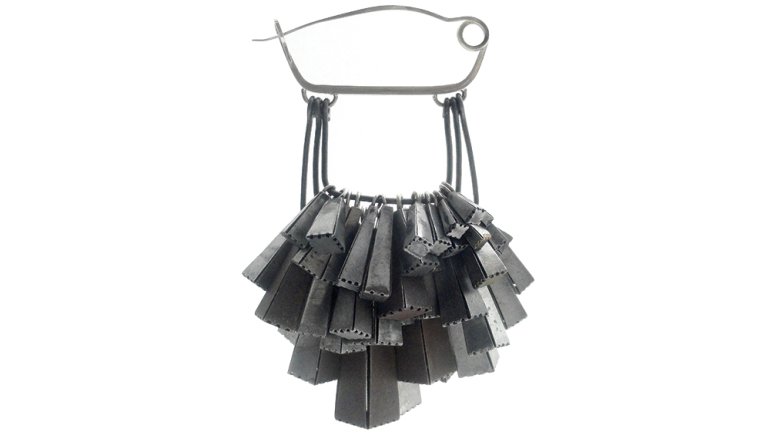The Natural
The Natural
Stone and steel and oxidized bits of tin: With raw materials like these, it’s no wonder Tova Lund’s jewelry can look aggressive and masculine, sort of like monuments, when an uninitiated visitor drops by her website. The home page features a steel and stone brooch with a matching inlay of decaying wood. Elsewhere on the site, another brooch hangs, seemingly heavy, with dozens of metal forms, almost like an outdoor sound sculpture.
But up close, Lund’s work is full of intricate detail and craftsmanship, lending it a surprising delicacy. Vintage tin forces Lund to load up on rivets and metal tabs, since heat would destroy the material’s charming character. Lund also has the habit of drilling pinholes along the seams of her creations, which gives the look of perforated edges.
“Her work feels very large-scale, like sculpture,” observes Gayle Eastman, a St. Louis-based fine art jeweler and veteran of the global art-fair circuit. “Yet when you hold a piece it evokes intimacy.” Eastman discovered Lund’s work two years ago, when the 29-year-old Lund was still a graduate student at Southern Illinois University Edwardsville, 20 miles northeast of St. Louis. “I saw a few of her pieces laid out and was immediately struck by her use of non-precious materials and the lavish attention to fine detail,” says Eastman, one of the first to collect Lund’s work. (She owns three rings and two brooches.)
Another early fan of Lund’s work is Merry Beck, owner of Gallery 360 in Minneapolis. Beck fell for Lund’s work last summer, just two months after the artist returned to her hometown of Minneapolis. The soft-spoken Lund was showing work at her first-ever art fair, a modest affair in a small city park. After seeing the work, Beck immediately invited Lund to do a trunk show in the gallery. “That was the start of a beautiful relationship. We’ve sold her jewelry as fast as she can bring it in,” says Beck, whose gallery was the first retailer to carry Lund’s work.
Growing up, Lund didn’t behave like the usual budding artist. She didn’t collect photography books or graphic novels. She collected rocks – and she still does. Asked about her formative childhood experiences, Lund can’t remember any art teachers or influential museum exhibitions; she remembers running wild through the outdoors near her parents’ cabin in northern Minnesota. Even today, Lund cites her major influences as landscape and “the movement of geology.”
Her latest pieces, with their elongated tin forms, were specifically inspired by the terrain of Giant’s Causeway, a formation of basalt columns on the northeast coast of Ireland. In 2002 Lund enrolled at the University of Wisconsin-Stout, 60 miles from the Twin Cities. For reasons she can’t explain, she picked a major at odds with her earthy personality and habits: interior design. Not surprisingly, she ended up feeling the subject “was too much computer stuff – too much AutoCAD.” During her junior year, she finally took a fateful metals class and immediately fell in love with the hands-on process of metalworking.
“I sort of frantically switched majors,” adding more time to her undergraduate tenure, Lund says.
Another turning point came during graduate school in 2010. Lund took a class with visiting artist Marlene True, a North Carolina-based metalsmith who uses lots of tin in her jewelry. Lund soon found herself similarly obsessed with this inexpensive material, especially the rich colors she saw in, say, a crusty 1950s tobacco tin. “Tin was an experiment when I first started using it,” she says. “But when I put it with the rocks it made sense.” Now she trolls antiques stores for the tin, and she picks up the stones while hiking or walking near her home in Minneapolis.
Back at her home studio, Lund assembles her findings on two enormous worktables. Then she allows herself a luxurious stretch of time to see the connections among her disparate collections. “For this piece,” she explains, picking up a brooch flecked with gorgeous browns and reds, “I was trying to relate the rust on this piece of tin with the actual iron of this stone.”
Despite rising demand from Gallery 360, plus a new part-time job teaching metals at her alma mater, Lund feels she has no choice but to persist in her painstaking process. “I’m precise about what I do,” she says, with a shy grin. “But I’m still going to be spontaneous about how I make things.”
Christy DeSmith is a Minneapolis-based freelance writer. She covers arts, culture, and travel.

